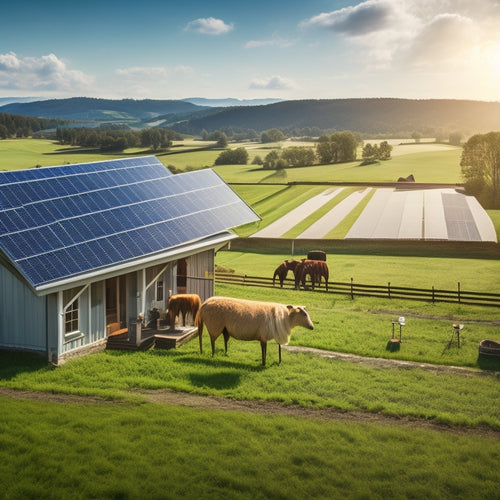
Why Commercial Solar Needs Energy Storage Solutions
Share
When you integrate commercial solar into your business's energy mix, you need a reliable way to stabilize the grid connection, mitigate peak demand charges, and guarantee backup power during outages, which is exactly what energy storage solutions provide. Without energy storage, you're exposed to unpredictable grid connections, peak demand charges, and power outages that can damage equipment and disrupt operations. Energy storage solutions absorb power fluctuations, reduce peak demand charges, and provide backup power during outages. By incorporating energy storage, you can ensure seamless grid integration, maximize your return on investment, and tap into the full potential of your solar energy system - and there's more to explore.
Key Takeaways
• Energy storage solutions protect commercial solar equipment from power outages, voltage fluctuations, and frequency deviations, ensuring smooth operation.
• Implementing energy storage reduces peak demand charges by shifting non-essential loads to off-peak hours, minimizing costs.
• Energy storage solutions ensure seamless integration with the grid, providing Frequency Regulation, Voltage Support, and Power Quality for renewable energy stability.
• Commercial solar energy storage systems provide backup power during grid outages, guaranteeing continuous operation for critical businesses and minimizing losses.
• Energy storage maximizes ROI by reducing peak demand charges, optimizing self-consumption, selling excess energy back to the grid, and capitalizing on government incentives.
Unpredictable Grid Connection Risks
When you connect your commercial solar energy system to the grid, you're exposed to unpredictable grid connection risks, including power outages, voltage fluctuations, and frequency deviations that can damage your equipment and disrupt your operations.
These power fluctuations can be particularly damaging to your system, causing equipment failure, reduced lifespan, and even complete system shutdown. Additionally, the grid's unpredictability can also lead to Grid Resilience issues, making it crucial to implement a robust energy storage solution that can absorb and stabilize power fluctuations, ensuring a smooth and reliable operation.
By doing so, you can protect your equipment, reduce downtime, and maintain business continuity. With a reliable energy storage system, you can enjoy the benefits of commercial solar energy while minimizing the risks associated with grid connection.
Peak Demand Charges Increase Costs
Your commercial solar energy system can actually enhance your peak demand charges, adding to your overall energy costs, especially during periods of high energy usage. This might seem counterintuitive, as you'd expect solar energy to reduce your reliance on the grid and lower your bills. However, most commercial solar systems don't provide a direct reduction in peak demand charges. This is because peak demand charges are based on your highest energy usage during a specific time period, usually 15-minute intervals. If your solar system can't provide power during these peak periods, you'll still be charged for that energy usage.
To avoid these Costly Peaks, you need to implement a strategy that reduces your peak demand. One effective approach is Demand Shifting, which involves storing excess energy generated by your solar system during the day and using it to power your facility during peak periods. By doing so, you can reduce your peak demand charges and lower your overall energy costs.
Renewable Energy Grid Stability
As you implement demand shifting strategies to reduce peak demand charges, you'll need to ensure that your commercial solar energy system integrates seamlessly with the grid, maintaining renewable energy grid stability to avoid disruptions to the power supply. This is vital because grid stability is essential for ensuring a reliable and efficient power supply.
To achieve grid stability, energy storage solutions can provide Frequency Regulation, which involves adjusting the energy output to match grid frequency requirements. This helps maintain a stable grid frequency, preventing power outages and equipment damage.
Grid Stability Components:
-
Grid Resilience: Ability of the grid to withstand and recover from disruptions
-
Frequency Regulation: Adjusting energy output to match grid frequency requirements
-
Voltage Support: Maintaining stable voltage levels to prevent equipment damage
- Power Quality: Ensuring a stable and reliable power supply
Backup Power During Outages
In the event of a grid outage, a commercial solar energy storage system can provide backup power, guaranteeing your business remains operational and minimizing downtime and associated losses. This is particularly vital for businesses that require continuous operation, such as hospitals, data centers, and emergency services. With a solar energy storage system, you can make certain that critical loads remain powered, even during an outage.
Here are some key benefits of having a backup power system:
-
Emergency Response: Guarantee business continuity during grid outages, minimizing the impact on your operations and reputation.
-
Critical Loads: Prioritize power supply to critical systems, such as refrigeration, lighting, and communication systems.
-
Reduced Downtime: Minimize losses by keeping your business operational, even during extended outages.
- Enhanced Resilience: Safeguard your business from the financial and reputational impacts of power outages.
Maximizing ROI With Energy Storage
By incorporating energy storage into your commercial solar energy system, you can enhance your return on investment (ROI) by reducing peak demand charges and maximizing self-consumption of generated electricity. This means you'll be generating revenue through selling excess energy back to the grid while minimizing your reliance on non-renewable sources.
To maximize ROI, you'll want to perform Tariff Optimization, analyzing your energy usage patterns to determine the most cost-effective rate structure. Additionally, conducting an Incentive Analysis will help you identify and capitalize on available government incentives, further increasing your ROI.
Frequently Asked Questions
Can Energy Storage Solutions Be Customized for Specific Industries?
You can tap into industry insights and sector analysis to tailor energy storage solutions to specific industries, ensuring optimized performance and efficiency, allowing you to break free from generic, one-size-fits-all approaches.
How Long Does It Take to Install Commercial Energy Storage Systems?
You'll typically spend 2-6 months on the installation timeline, but be prepared to navigate permitting hurdles, which can add 1-3 months, depending on local regulations and complexity of your commercial energy storage system.
Are Energy Storage Solutions Compatible With Existing Solar Infrastructure?
You'll find that energy storage solutions seamlessly integrate with existing solar infrastructure, ensuring a smooth system integration and panel compatibility, creating an energy synergy that harmonizes with the grid, making an infrastructure upgrade a breeze.
Can Energy Storage Increase the Lifespan of Commercial Solar Panels?
As you harness the sun's power, you'll find energy storage can be a guardian angel for your commercial solar panels, reducing panel degradation and boosting battery longevity, giving you a brighter, more sustainable future.
Do Energy Storage Systems Require Ongoing Maintenance and Repair?
You'll need to perform regular checks on your energy storage system to prevent component failure, ensuring a prolonged battery lifespan, and staying on top of system upgrades to maintain peak performance.
Related Posts
-

Evaluating Solar Power Options for Businesses
Evaluating solar power options for your business can greatly reduce energy costs and enhance sustainability. Start by...
-

Solar Power Backup Solutions During Outages
Solar power backup solutions guarantee you have reliable energy during outages, providing essential power when the gr...
-

Solar Power Systems for Rural Properties
Solar power systems offer a reliable and efficient energy solution for rural properties, allowing you to gain energy ...


